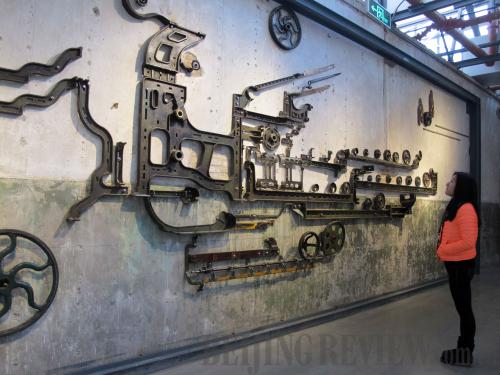|
 |
|
HERITAGE ON DISPLAY: A sculpture depicting a phoenix made of textile machinery parts is housed in the Xi'an Industrial Heritage Museum, which was remolded from a bankrupted textile plant in the capital city of Shaanxi Province (FENG GUO) |
In terms of industrial heritage protection was new to the Chinese people. "In this area, we were 20 years behind European countries," said Wen Zongyong, President of the Beijing Institute of Surveying and Mapping.
International efforts to protect industrial heritage started from the 1970s. In 2003, the International Committee for the Conservation of the Industrial Heritage adopted the Nizhny Tagil Charter, which defines industrial heritage and has become a guiding document for protection efforts worldwide.
In November 2011, the 17th General Assembly of the International Council on Monuments and Sites passed the Dublin Principles, which spell out standards for industrial heritage conservation.
In response to international efforts in this area, in April 2006, Chinese government officials in charge of cultural relic preservation, representatives of cities rich in industrial heritage and experts in the field gathered in Wuxi, east China's Jiangsu Province, to mark International Day for Monuments and Sites, which carried the theme of industrial heritage. Wuxi is the cradle for China's traditional industry and township enterprises. Participants put forward the Wuxi Proposals for inscribing and protecting industrial heritage in China.
As of 2013, among the 4,295 key cultural relic sites inscribed by the State Council, 329 were industrial heritage sites, including 245 in a broad sense and 84 in the narrow sense.
Meanwhile, as of 2013, the UNESCO's World Heritage List includes 50 industrial heritage sites in 25 countries, while the 2,000-year-old Dujiangyan Irrigation System in southwest China's Sichuan Province is the country's only such site on the list. Industrial heritage sites account for 5 percent of all heritage sites on UNESCO's list.
As China promotes ecological progress, urbanization and the building of a moderately prosperous society, it is attaching increasing importance to industrial heritage conservation.
Reusable
The reuse value of industrial heritage is the highest among all cultural heritages, according to Dong Wei, an architectural professor in Nanjing-based Southeast University. As a result, industrial heritage sites can be preserved in different ways from regular cultural relics, he added.
In recent years, China has recorded successful cases of industrial heritage protection. A number of ancient porcelain kilns in Jingdezhen in east China's Jiangxi Province, known as the country's Porcelain Capital, have been put under protection while in operation. The earliest kilns date back more than 1,000 years.
The 798 Art Zone, Beijing's leading concentration of contemporary art galleries, has been converted from a cluster of shuttered factories built in the 1950s. A water plant in Beijing's downtown Dongzhimen area has been transformed into the Beijing Tap Water Museum.
While industrial heritage sites are reused, some problems have occurred. Zhan Erpeng, a deputy inspector with the Urban Planning Bureau of Qingdao, east China's Shandong Province, said that sometimes, industrial heritage sites are used as advertisements while their basic function as a cultural carrier has been marginalized.
Industrial heritage protection should not be regarded as a passing trend, and the protection method should be customized and more imaginative, said Peking University's Yu, one of the major drafters of the Wuxi Proposals.
Currently, a major complaint among cultural relic experts is that the reuse of industrial heritage sites mainly focuses on transforming them into museums and creative industry parks, or even development of commercial properties.
The models of industrial heritage conservation should be diversified and resourceful, said Southeast University's Dong. He suggested that industrial heritage sites should be used reasonably and sustainably, and protection and urban development should be integrated, so that old memories can be retained amid rapid urban construction.
Shan said that industrial heritage protection should follow three standards: First, industrial heritage sites should be renovated and made attractive; second, they should be used to promote social and economic development; third, they should benefit the general public.
"Only if the general public can benefit from industrial heritage protection, will they become involved in it," he said.
Email us at: tangyuankai@bjreview.com | 